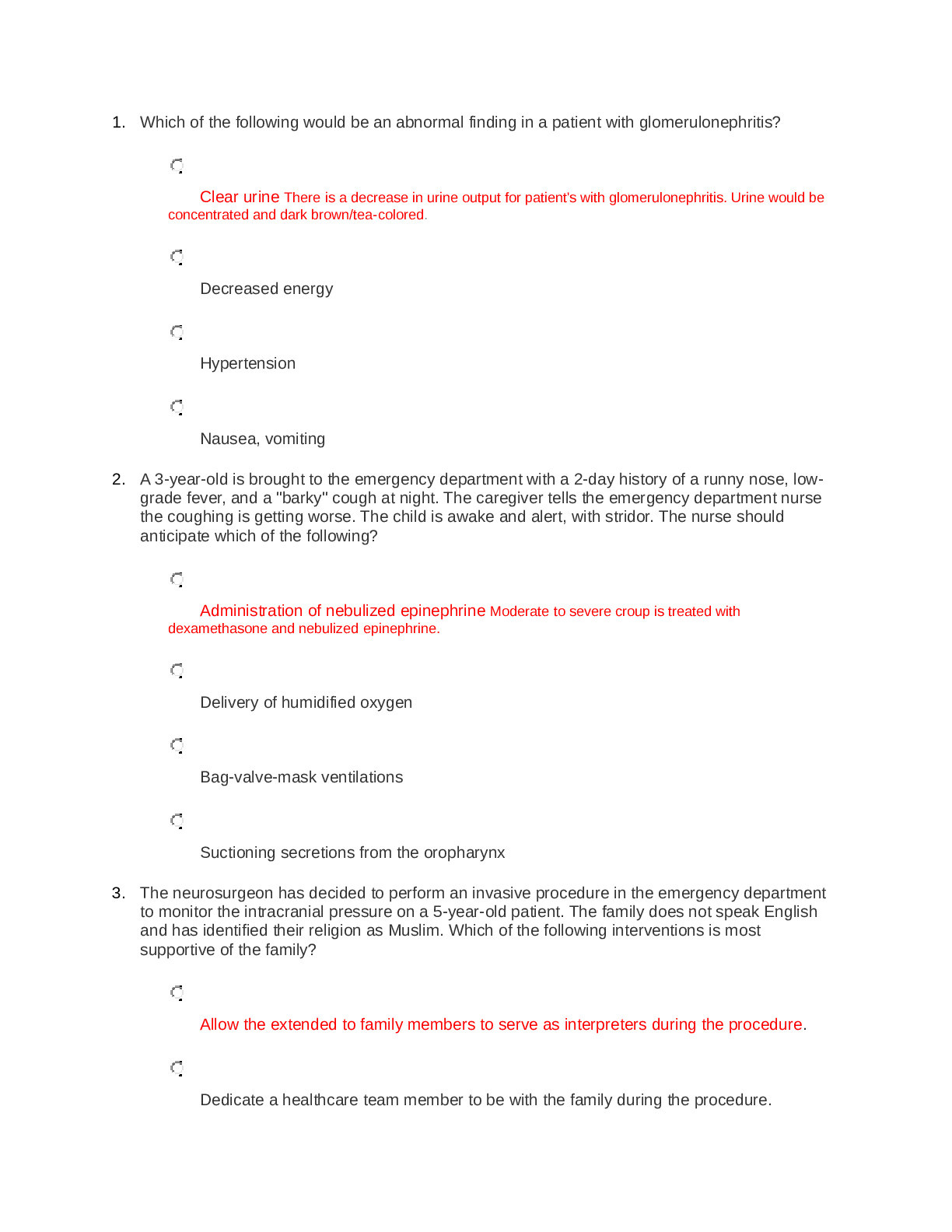All study resources > ENPC exam answers (Nursing)
ENPC exam answers
1. Which of the following would be an abnormal finding in a patient with glomerulonephritis?
Clear urine There is a decrease in urine output for patient's with glomerulonephritis. Urine would be
concentrated and dark brown/tea-colored.
Decreased energy
Hypertension
Nausea, vomiting
2. A 3-year-old is brought to the emergency department with a 2-day history of a runny nose, lowgrade
feve
...[Show More]
1. Which of the following would be an abnormal finding in a patient with glomerulonephritis?
Clear urine There is a decrease in urine output for patient's with glomerulonephritis. Urine would be
concentrated and dark brown/tea-colored.
Decreased energy
Hypertension
Nausea, vomiting
2. A 3-year-old is brought to the emergency department with a 2-day history of a runny nose, lowgrade
fever, and a "barky" cough at night. The caregiver tells the emergency department nurse
the coughing is getting worse. The child is awake and alert, with stridor. The nurse should
anticipate which of the following?
Administration of nebulized epinephrine Moderate to severe croup is treated with
dexamethasone and nebulized epinephrine.
Delivery of humidified oxygen
Bag-valve-mask ventilations
Suctioning secretions from the oropharynx
3. The neurosurgeon has decided to perform an invasive procedure in the emergency department
to monitor the intracranial pressure on a 5-year-old patient. The family does not speak English
and has identified their religion as Muslim. Which of the following interventions is most
supportive of the family?
Allow the extended to family members to serve as interpreters during the procedure.
Dedicate a healthcare team member to be with the family during the procedure.
Allowing caregivers to remain with the pediatric patient is more supportive in this
situation. Allow family members to serve as interpreters during the procedure
Provide access to nondenominational clergy in a quiet area
4. Which of the following patient presentations should increase suspicion of potential child
maltreatment?
Right radial spiral fracture in a 10-year-old practicing martial arts
Bruising to the left ear of a newborn from sleeping on his side Any bruise in a nonexploratory
location in children younger than 4 years and any bruising in a child younger than 4 months
(TEN-4) are cause for suspicion of abuse.
Closed greenstick wrist fracture in a 4 year old who fell off his bicycle
Bruises in various stages of healing to the lower extremities of a 2-year-old
5. A 14-year-old high school student who was pitching for his baseball team was hit in the chest by
the ball and had a sudden cardiac arrest. Of the following, which is the most likely cause of the
cardiac arrest?
Aortic Dissection
Commotio cordis Commotio cordis occurs when the chest is struck during the refractory period of
the cardiac conduction cycle, resulting in a ventricular dysrhythmia or asystole. This type of injury usually
occurs in recreational sports such as baseball or ice hockey.
Pericardial Tamponade
Blunt Aortic Injury
6. A 12-year-old who was recently started on anti-psychotic medication for schizophrenia is brought
to the emergency department with severe muscle rigidity and hyperthermia. These symptoms
are most likely caused by which of the following?
Ecstasy overdose
Neuroleptic malignant syndrome These are classic symptoms of neuroleptic malignant syndrome,
which is a rare reaction to antipsychotic medications.
Serotonin syndrome
Nicotine overdose
7. Which of the following patients should be evaluated first?
A 3-year-old with a dislodged gastrostomy tube
A 12-year-old with left shoulder pain after a handlebar injury
An 18-month-old with bilious emesis Bilious emesis in an 18-month-old is always considered an
emergent symptom indicative of a life-threatening bowel obstruction.
A 3-month-old with periods of inconsolable crying
8. Which of the following tasks can the nurse do to decrease adverse medication events?
Obtain the patient's weight in kilograms This is the preferred measurement for medication
calculations for pediatric and adult patients.
Verifying the patient dose during shift report at nursing station
Dual confirmation of a hard to read order
Confirming patient's attending provider
9. Acute chest syndrome, stroke, and splenic sequestration are complications of which of the
following diseases?
[Show Less]
